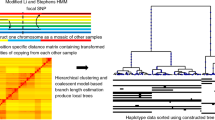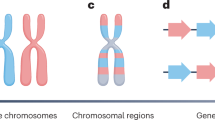Abstract
Replying to: J. Wakeley Nature 452, 10.1038/nature06805 (2008)
In his communication1, Wakeley does not find any flaw in our argument for complex speciation of humans and chimpanzees2, nor has he identified a simple demographic model that can explain the notable differences in genetic divergence that we observe between humans and chimpanzees when comparing chromosome X and the autosomes.
Similar content being viewed by others
Main
Our argument2 for complex speciation rests on the difference in genetic divergence time that we observe between chromosome X and the autosomes, and not on the wide range of genetic divergence times observed within the autosomes (which can indeed be explained by a large ancestral population size3,4). To reiterate our argument for complex speciation, we began with a null model of simple speciation in which the ancestral populations of humans and chimpanzees were separated by a barrier with no subsequent gene flow. Fitting this model to our data, we obtain an expectation for the genetic divergence on chromosome X. However, the observed chromosome X data differ from this, and we could not explain the difference even by using more elaborate demographic histories. Wakeley’s model of demographic history can explain only the autosomal data, and does not reconcile the autosomal and chromosome X data, even though comparing these two parts of the genome provides the key signal for complex speciation. Table 1 shows three statistics that are each sensitive to human–chimpanzee genetic divergence on chromosome X: all are significantly reduced (4.4–8.3 s.d.) compared with that predicted from Wakeley’s simple model fitted to our autosomal data.
Wakeley1 suggests that the ratio of male-to-female mutation rate in primates (α) might be higher than we estimated. This would not explain the data, especially in light of our human–gorilla comparison. Using Wakeley’s method1 for calculating α with raw genetic divergence data (rather than by comparison with an outgroup2), we estimate α = 3.19 from the human–chimpanzee comparison, similar to the value Wakeley reports (the slight difference is owing to our correction for recurrent mutation). But this disagrees with our α = 1.57 obtained from the same calculation using the human–gorilla comparison.
If mutation-rate differences alone could explain the observed data, we would expect a consistent value for α from the human–chimpanzee and human–gorilla divergence data, but estimates of α are significantly different (P = 0.001). A high value of α also cannot explain other important features in Table 1: the near-absence of sites on chromosome X that cluster humans and gorillas or chimpanzees and gorillas; or why human–gorilla divergence should not be reduced on chromosome X (such a reduction would be expected if high male mutation rate were responsible for low human–chimpanzee genetic divergence on chromosome X).
What could explain the evidence for reduced chromosome-X time divergence? We suggested hybridization2. In hybrids, genetic barriers to gene flow often map to chromosome X (ref. 5). A corollary is that if a hybrid population overcomes these barriers, it may experience intense selection to eliminate most or all the chromosome X contribution from one of the ancestral populations—the population cannot tolerate the sequence of both X chromosomes and one is selected away. When hybridization between two populations establishes a third population, the divergence on chromosome X will be large relative to one ancestral population and small relative to the other, depending on which ancestral chromosome X is selected away. Depending on which populations survive to the present day, the divergence on chromosome X will be very high or very low relative to that on the autosomes (but not intermediate), which would explain the low observed chromosome X divergence.
We therefore reject the simple model of speciation that Wakeley proposes, having also investigated other simple speciation models and found none to explain the data2. In contrast, hybridization followed by natural selection across the entire chromosome X to eliminate hybrid sterility or inviability loci does explain the data2. To argue against the evidence for complex speciation, an alternative simple model is needed that explains the reduced chromosome X divergence in humans and chimpanzees with no similar reduction for humans and gorillas. No one has yet succeeded in identifying such a model.
References
Wakeley, J. Complex speciation of humans and chimpanzees. Nature 452 10.1038/nature06805 (2008)
Patterson, N., Richter, D. J., Gnerre, S., Lander, E. S. & Reich, D. Genetic evidence for complex speciation of humans and chimpanzees. Nature 441, 1103–1108 (2006)
Barton, N. H. Evolutionary biology: how did the human species form? Curr. Biol. 16, 647–650 (2006)
Innan, H. & Watanabe, H. The effect of gene flow on the coalescent time in the human–chimpanzee ancestral population. Mol. Biol. Evol. 23, 1040–1047 (2006)
Coyne, J. A. & Orr, H. A. in Speciation and its consequences (eds Otte, D. & Endler, J. A.) 180–207 (Sinauer Associates, Sunderland, Massachusetts, 1989)
Author information
Authors and Affiliations
Rights and permissions
About this article
Cite this article
Patterson, N., Richter, D., Gnerre, S. et al. Patterson et al. reply. Nature 452, E4 (2008). https://doi.org/10.1038/nature06806
Issue Date:
DOI: https://doi.org/10.1038/nature06806
This article is cited by
-
A neuronal aging pattern unique to humans and common chimpanzees
Brain Structure and Function (2016)
-
The evolution of the upright posture and gait—a review and a new synthesis
Naturwissenschaften (2010)
Comments
By submitting a comment you agree to abide by our Terms and Community Guidelines. If you find something abusive or that does not comply with our terms or guidelines please flag it as inappropriate.



